Dog Allergies
How can I tell if my dog has allergies?

When a dog suffers from allergies, symptoms may not be noticeable at first. Although most allergic conditions are not typically life-threatening to dogs, they can certainly cause a tremendous amount of discomfort. Most allergy symptoms in dogs are dermatologic signs affecting the skin and ears. However, allergies in dogs can manifest in a variety of ways, which can lead to chronic dermatologic, GI, and respiratory issues if left untreated.
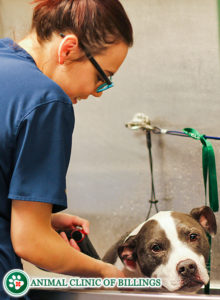
If your dog has allergies, you may notice him or her exhibiting one or more of the following symptoms:
- Compulsive scratching
- Excessive Licking
- Biting or chewing at parts of the body
- Regularly rubbing against the ground, walls, or furniture
- Sneezing
- Skin redness or hair loss
If you notice your dog presenting any of the above symptoms, we recommend making a veterinary appointment as soon as possible to determine what factors are at play and institute effective treatments.

Most dogs develop allergies after the age of two, and the majority of allergen exposure in dogs occurs through contact with the skin. A smaller number of allergies are caused by food (usually the protein source) and inhalants (breathed in through the air). Starting as early as 6 months of age, the immune system may begin to overreact to antigen(s), causing activation of immune cells that produce inflammatory substances (such as histamine), which lead to the symptoms of inflammation and itching.

The majority of allergic dogs have impairment of their normal skin barrier functions, which allows antigens to enter the skin more easily. The weakened skin barrier in dogs with allergies allows for colonization by bacteria and yeasts, resulting in secondary infections. Typically, an allergic dog has reactions to multiple allergens, and their symptoms are due to a complex set of factors that often vary with changes to their environment.
Early diagnosis and treatment of allergies not only increases the likelihood of your dog’s treatment being successful but can also be more cost effective than delaying treatment. Secondary infections tend to become more severe the longer you wait, and given the significant impact of allergies on your dog’s comfort, early intervention is essential in maintaining a good quality of life.
WHAT CAUSES A DOG TO DEVELOP ALLERGIES?

Think of your dog’s skin like saran wrap, covering and protecting the dog’s body. Allergies in dogs result from genetic defects that cause impairment of the skin’s normal barrier structure (think of holes in the saran wrap).
These flaws in the skin allow for the allergens to enter the skin and set off an allergic response, causing itching and redness. It is essential to understand that dogs who suffer from allergies do not have healthy skin. In addition, these dogs do not have a normal healthy immune response.
Inflammation in the skin will further alter the dog’s skin health by allowing bacteria and yeast to more easily enter the dog’s body and cause an infection of the skin and potentially deeper tissues. When a dog suffers from allergies, their skin and immune response may be inadequate to fight off these bacterial and yeast invaders.
DOG ALLERGY TESTING
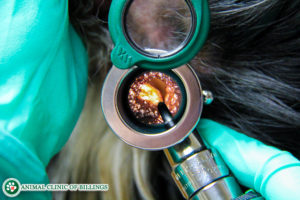
A thorough exam by your veterinarian is the first step in determining the cause of your dog’s symptoms. In addition to examining for external skin parasites (i.e., fleas and mites), your veterinarian will want to perform some diagnostics to help determine what types of infections may exist.
Your veterinarian may consider allergy testing after diagnosing and treating for any external parasites and infections. If they believe that allergies are the root cause of your dog’s skin irritation and discomfort, then they may suggest testing for specific allergens. There are a multitude of things to test for in determining what is causing allergies.
Dog allergies fall into the following groups:
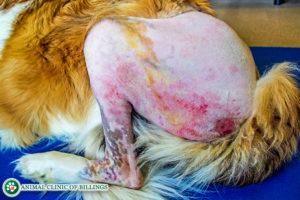
Environmental allergies
Environmental allergies involve reactivity to many different kinds of plants, grasses, molds, dust mites, and other materials in a dog’s indoor and outdoor living environment. These allergens incite a reaction through contact with the skin, and are the most prevalent type of allergies seen in dogs. The body’s response to these allergens often causes a reaction focused primarily within the epidermis, resulting in severe inflammation and itchiness. Skin infections and injuries can result from constant scratching as a dog attempts to relieve their intense itching.
Flea allergies
Flea bites are a very common cause of allergies in dogs, and just a single flea bite can set off severe signs in a flea-allergic dog.
Food allergies
Food allergies include reactivity to components of dog foods and human foods; while dogs can develop an allergy to almost any ingredient, the most common food allergies seen in dogs involve protein sources.
Inhalant allergies
Inhalant allergies are caused by allergens inhaled into the respiratory tract from the air such as pollen, mold, and dust.
Types of allergy tests on dogs
There are two types of allergy tests in dogs. Blood testing and intradermal skin testing are performed differently, and each has its benefits and drawbacks.
Allergy testing on dogs should be done during a specific season(s) when the allergy is the worst to maximize the odds of obtaining accurate results.

Testing should be performed after evaluating for other potential causes and irritants, including:
- Ectoparasites (Mites, Fleas, Lice, etc.)
- Fungal or yeast infections of the skin
- Chronic bacterial infections (common secondary invaders)
- Hypothyroidism and other endocrine diseases
A veterinarian might also institute a 12-week hypoallergenic diet to rule out a possible food allergy. Food allergies are challenging to detect using either of the testing methods mentioned, and therefore, are generally diagnosed through dietary manipulation. Once all of these various possibilities are ruled out, either a blood test or skin test will be ordered to determine the cause of a dog’s allergies.
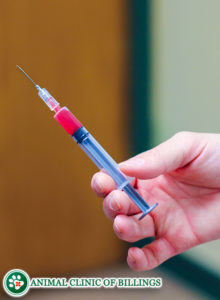
Blood allergy testing in dogs
The most common and simplest type of allergy testing in dogs is through a blood test. Our veterinarians do this by taking a small sample of a dog’s blood and analyzing it for the presence of antibodies to a wide variety of regionally-specific allergens (antigens), including:
- Pollens
- Dust
- Mold
- Mites
- Household materials (cotton, wool)
Unfortunately, blood allergy tests are not reliable in identifying food allergies in dogs. Blood tests are often preferred because they are much less invasive and time-consuming than intradermal skin testing for allergies in dogs.
How are allergies treated in dogs?
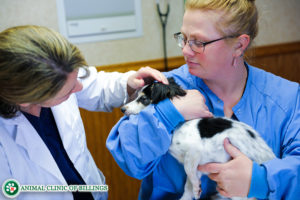
Dog allergies can’t be cured, but they can be successfully controlled and treated. There are many types of allergy treatment options for dogs, which include combining oral medications, topical medications, medicated baths, and injectable antigen therapies.
Choosing the most suitable allergy medications for a dog depends on what their symptoms are, the severity of their symptoms, and whether they have any preexisting medical conditions that may be affected by specific prescribed medications.
The following categories of medications are commonly used in dogs that are suffering from allergies.
 Anti-inflammatory medications
Anti-inflammatory medications
Anti-inflammatory drugs such as corticosteroids are a common form of allergy treatment for dogs. These medications inhibit most allergic reactions quickly and are commonly used as an initial treatment for controlling the severe itch associated with allergies in dogs. Long-term use, especially in high doses, can cause serious side-effects, so often these are used only short-term while other medications are taking effect.
Antihistamines
This class of medications, including Benadryl, Claritin, Zyrtec, and others, help to inhibit the release of histamine from immune cells, which are one major cause of the itchiness and redness associated with allergies.
Immune modulators
Immune modulators modify a dog’s immune response to be less reactive to allergens and to produce less of the mediators that cause a dog to feel itchy. These come in both oral and long-acting injectable forms.
Food and Dietary supplements
Some dogs have allergies only to food ingredients, in which case a veterinarian will advise that a dog be switched to a special diet and potentially recommend omega-3 fatty acid supplementation, which can help enhance an allergic dog’s response to medical therapy in some cases.
 Topical therapy
Topical therapy
Bathing can be beneficial for dogs with allergies to physically remove antigens they’ve accumulated on their skin and fur, and also to remove dead skin cells, bacteria, and yeasts. Medicated shampoos can help treat secondary infections with yeast and bacteria that may be present in dogs with skin allergies. Therapeutic shampoos containing anti-inflammatory ingredients are also very soothing for dogs suffering from skin allergies.
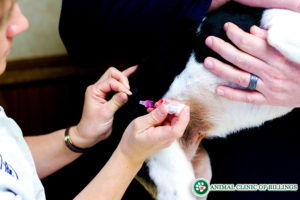 Hyposensitization therapy
Hyposensitization therapy
When specific allergens are identified through allergy testing, allergy shots may be recommended. Hyposensitization therapy consists of weekly injections of gradually increasing amounts of a custom-formulated antigen serum. The aim of this therapy is to reprogram or desensitize a dog’s immune system to stop reacting to the allergens. Often it takes 4-6 months to start seeing results, so many dogs are placed on other allergy medications for the first few months to help control their symptoms until the allergy shots have a chance to take effect.
To learn which allergy medicine or allergy treatment methods will work best for your dog, please call one of our friendly receptionists to schedule an allergy appointment with one of our veterinarians today.
Every allergy case our veterinarians see in dogs is different and must be approached on a case by case basis.
406-252-9499
What is the best dog food for dogs with allergies?

Among the many types of allergies our veterinarians commonly see in dogs, we regularly see cases of dogs suffering from an allergic reaction to one or more ingredients in their dog food.
The only way to determine if your dog has a food allergy is to conduct a controlled elimination test of the ingredients in the food they are currently eating. This is most commonly done by switching your dog to a specially-formulated allergen-free diet for at least 6-8 weeks. The ingredients in their former diet can then be re-introduced one at a time to determine which ones were causing the allergy.
Approximately 10% of dog allergies result from food-based antigens, which makes it essential to schedule an allergy testing appointment with one of our veterinarians if food allergies are suspected so that we can determine the best way to help your dog live a more comfortable life.

Let our highly trained and experienced team of veterinarians and veterinary technicians help you keep your pet as happy and healthy as they can be.
Call the Animal Clinic of Billings to schedule your pets next wellness examination with us today!
406-252-9499
ANIMAL CLINIC OF BILLINGS AND ANIMAL SURGERY CLINIC
providing our region’s companion animals and their families what they need and deserve since 1981
1414 10th St. West, Billings MT 59102
406-252-9499



